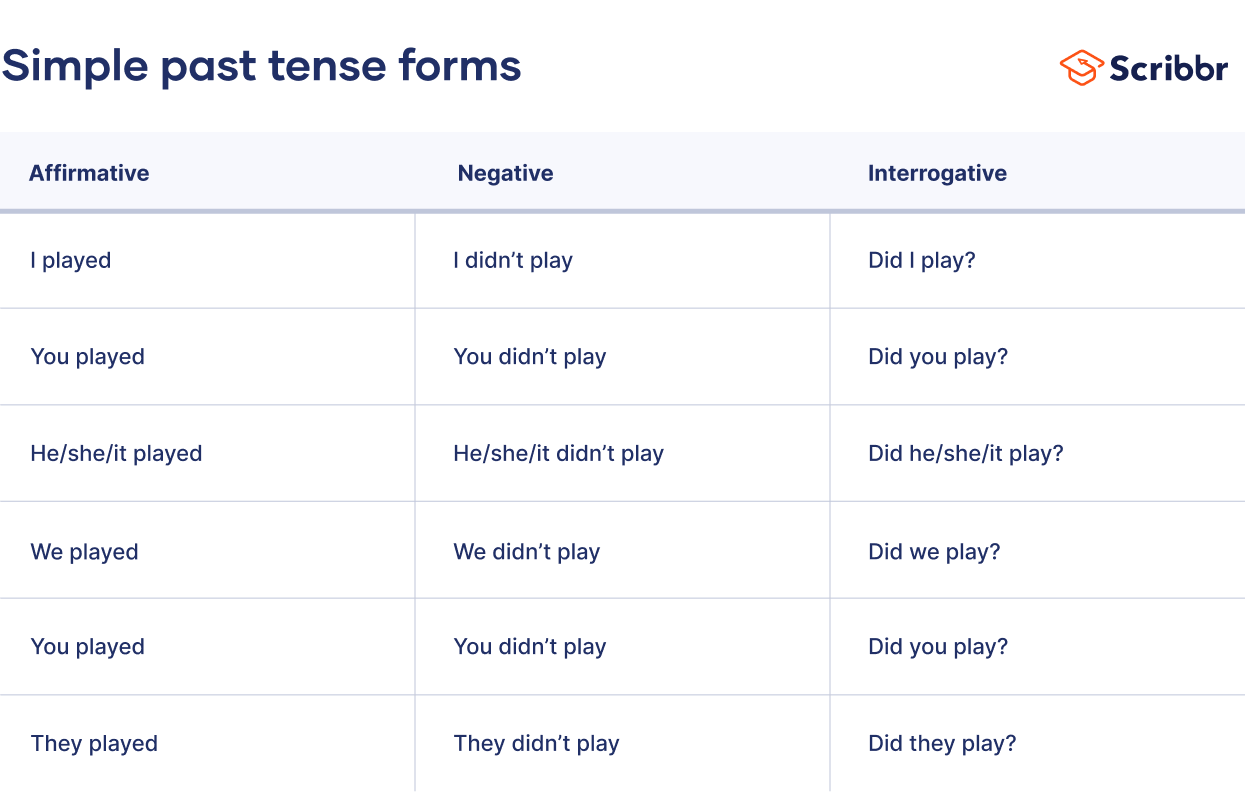Past Simple | Examples & Exercises
The past simple tense is a verb form used to refer to an action or series of actions that were completed in the past.
The past simple tense of regular verbs is formed by adding “-ed” to the infinitive form of the verb (e.g., “cook” becomes “cooked”). Most verbs in the simple past take the same form regardless of the subject (e.g., “He worked/we worked”).
How to use the past simple
The past simple tense (also called the simple past or preterite) is used to describe an action or series of actions that occurred in the past.
The past simple of regular verbs is typically formed by adding “-ed” to the end of the infinitive (e.g., “talk” becomes “talked”).
Irregular verbs don’t follow a specific pattern: some take the same form as the infinitive (e.g., “put”), while others change completely (e.g., “go” becomes “went”).
Most verbs in the simple past tense don’t follow subject-verb agreement (i.e., they don’t change form depending on the subject).
Ariana rented a car and drove to the coast.
We visited a museum, walked the Champs-Élysées, and dined at a fancy restaurant.
I saw the sunrise this morning.
Forming the simple past
The simple past of regular verbs is usually formed by adding “-ed” to the end of the verb (e.g., “guess” becomes “guessed”). However, this can vary depending on the verb’s ending.
| Original ending | Simple past ending | Example |
| -e | -add “d” | love; loved |
| short verbs, where the last three letters follow a consonant-vowel-consonant pattern | -double the last letter and add “-ed” | stop; stopped plan; planned |
| long verbs with a stressed syllable at the end, where the last three letters follow a consonant-vowel-consonant pattern | -double the last letter and add “-ed” | prefer; preferred admit; admitted |
| Consonant + y | -ied (replacing the “y”) | try; tried |
Irregular verb: “be”
The stative verb “be” in the simple past tense is used to describe unchanging past conditions (e.g., “My father was a good man”) and temporary past situations (e.g., “The children were tired”). Unlike other verbs in the simple past, “be” changes form depending on the subject, as shown in the table below.
| Subject | Verb |
| I | was |
| You | were |
| He/she/it | was |
| We | were |
| You | were |
| They | were |
Present perfect vs past simple
Both the present perfect and past simple tenses are used to refer to past action. However, they serve different purposes:
- The present perfect is used to refer to an action that began in the past and may continue or to an action that took place in the past and has present consequences.
- The past simple is typically used to describe an action that was completed in the past and is not ongoing.
I have run a marathon before. [I may run a marathon again]
I was a vegetarian when I was younger.
I have been a vegetarian for two years. [I am still a vegetarian]
Simple past vs past perfect
While the past simple is used to describe an action or series of actions that occurred in the past, the past perfect is used to indicate that an action was completed before another past action began.
The guests had eaten the cake by the time Sophia arrived.
How to form negatives
In the past simple tense, negative statements are formed by adding “did not” (or the contraction “didn’t”) between the subject and the infinitive form of the verb.
The audience members didn’t enjoy the performance.
For the verb “be,” negative statements are formed by adding “was not/were not” (or the contractions “wasn’t/weren’t”) after the subject.
The students were not prepared for the exam.
How to form questions
To ask a yes–no question using the simple past, add “did” before the subject and the infinitive form of the verb.
Did Andy forget to file the report?
To ask a question starting with a wh-word (an interrogative pronoun like “who” or an interrogative adverb like “where”), follow the same word order as above, but add the pronoun or adverb at the start of the sentence.
Why did Eva leave so early?
When did Jose call?
How to form the passive voice
Passive sentences are ones in which the subject is not the person or thing performing the action. Instead, the subject is the person or thing being acted upon.
In the past simple, passive constructions are formed using a subject, “was”/“were”, and the past participle of the verb.
Maria was ignored by the salesman.
The gift was stolen.
Exercises: Past simple tense
Practise using the past simple correctly with the exercises below. In the blank space in each sentence, fill in the correct past simple form based on the subject and verb specified (e.g., “[he / talk]” becomes “he talked”). Some answers may also be negative statements or questions.
- __________ [you / go] to the shop this morning.
- __________ [they / play] a board game.
- __________ [my son / not / study] for the exam.
- __________ [the band / rehearse] every day this week.
- __________ [I / plan] to be home by six!
- When __________ [you / travel] to France?
- You went to the shop this morning.
- The past simple form of the irregular verb “go” is “went”.
- They played a board game.
- The past simple form of the regular verb “play” is “played”.
- My son did not study for the exam.
- In the past simple tense, negative statements are formed by adding “did not” (or the contraction “didn’t”) between the subject (“my son”) and the infinitive form of the verb (“study”).
- The band rehearsed every day this week.
- The past simple form of the regular verb “rehearse” is “rehearsed”.
- I planned to be home by six.
- For short verbs, where the last three letters follow a consonant-vowel-consonant pattern (e.g., “plan”), you double the final consonant and add “-ed”.
- When did you travel to France?
- To ask a question starting with a wh-word, add the wh-word at the start of the sentence, followed by “did”, the subject (“you”), and the infinitive form of the verb (“travel”).
Other interesting language articles
If you want to know more about commonly confused words, definitions, common mistakes, and differences between US and UK spellings, make sure to check out some of our other language articles with explanations, examples, and quizzes.
Frequently asked questions about the simple past tense
Cite this Scribbr article
If you want to cite this source, you can copy and paste the citation or click the ‘Cite this Scribbr article’ button to automatically add the citation to our free Reference Generator.
Ryan, E. (2023, October 30). Past Simple | Examples & Exercises. Scribbr. Retrieved 9 April 2025, from https://www.scribbr.co.uk/verb/past-simple/




